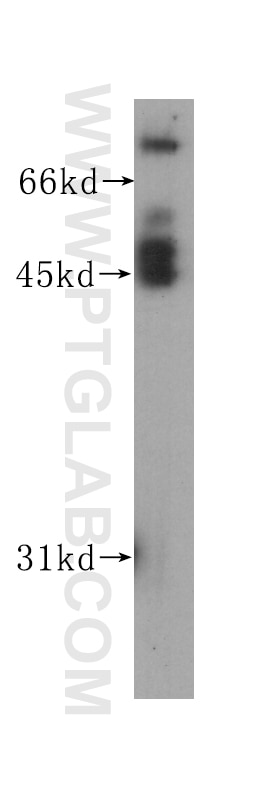Anticorps Monoclonal anti-Beta Tubulin
Beta Tubulin Monoclonal Antibody for ELISA
Hôte / Isotype
Mouse / IgM
Réactivité testée
Humain, souris
Applications
WB, ELISA
Conjugaison
Non conjugué
CloneNo.
5H9D7
N° de cat : 60039-1-Ig
Synonymes
Galerie de données de validation
Applications publiées
| WB | See 2 publications below |
Informations sur le produit
60039-1-Ig cible Beta Tubulin dans les applications de WB, ELISA et montre une réactivité avec des échantillons Humain, souris
| Réactivité | Humain, souris |
| Hôte / Isotype | Mouse / IgM |
| Clonalité | Monoclonal |
| Type | Anticorps |
| Immunogène | Beta Tubulin Protéine recombinante Ag0117 |
| Nom complet | tubulin, beta 3 |
| Masse moléculaire calculée | 450 aa, 50 kDa |
| Poids moléculaire observé | 55 kDa |
| Numéro d’acquisition GenBank | BC000748 |
| Symbole du gène | TUBB3 |
| Identification du gène (NCBI) | 10381 |
| Conjugaison | Non conjugué |
| Forme | Liquide |
| Méthode de purification | Chromatographie d'affinité thiophilique |
| Tampon de stockage | PBS with 0.02% sodium azide and 50% glycerol |
| Conditions de stockage | Stocker à -20°C. Stable pendant un an après l'expédition. L'aliquotage n'est pas nécessaire pour le stockage à -20oC Les 20ul contiennent 0,1% de BSA. |
Informations générales
There are five tubulins in human cells: alpha, beta, gamma, delta, and epsilon. Tubulins are conserved across species. They form heterodimers, which multimerize to form a microtubule filament. An alpha and beta tubulin heterodimer is the basic structural unit of microtubules. The heterodimer does not come apart, once formed. The alpha and beta tubulins, which are each about 55 kDa MW, are homologous but not identical. Alpha, beta, and gamma tubulins have all been used as loading controls. Tubulin expression may vary according to resistance to antimicrobial and antimitotic drugs.
Publications
| Species | Application | Title |
|---|---|---|
J Med Chem Novel Indoleamine-2,3-Dioxygenase-Targeted Pt(IV) Prodrugs Regulate the Tumor Immune Microenvironment to Achieve Chemoimmunotherapy In Vitro and In Vivo | ||
Transbound Emerg Dis Recombinant PRV Expressing GP3 and GP5 of PRRSV Provides Effective Protection Against Coinfection With PRV and PRRSV |


